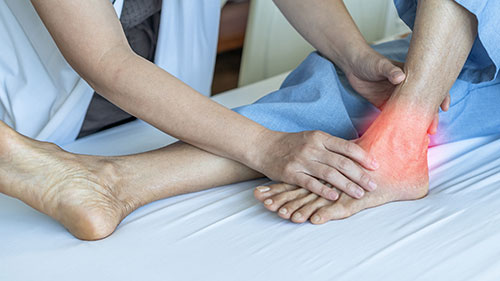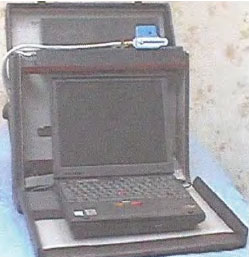Treatment for Tarsal Tunnel Syndrome
At Nebraska Hand and Shoulder, our specialists provide comprehensive care for tarsal tunnel syndrome, offering personalized treatment plans tailored to relieve symptoms, restore sensation, and improve foot mobility. Through targeted and effective treatments, we aim to alleviate discomfort and safeguard your foot health, helping you maintain an active and pain-free lifestyle. Don’t delay—contact us today to learn more and download our Tarsal Tunnel Patient Brochure to take the first step toward recovery!

What Is Tarsal Tunnel Syndrome?
Tarsal tunnel syndrome is a condition caused by pressure on the tibial nerve as it passes through the ankle’s tarsal tunnel, a narrow space near the inner anklebone. This compression often leads to symptoms like pain, a burning sensation, or numbness in the arch of the foot and ankle. It commonly affects adults over 30 and is linked to factors like obesity, diabetes, or prior injuries such as ankle sprains. In diabetics, subtle nerve swelling in confined spaces can contribute to developing tarsal tunnel syndrome, even with well-controlled blood sugar.
The condition may result from soft tissue or structural issues, such as nerve compression under the fibrous abductor hallucis muscle or the inferior extensor retinaculum. Symptoms can overlap with other nerve entrapments, such as carpal tunnel syndrome or peroneal nerve compression near the knee, making proper diagnosis crucial. Preoperative nerve testing can help identify the affected nerves and guide treatment. While often mistaken for untreatable diabetic neuropathy, ankle tarsal tunnel syndrome is a treatable condition that can significantly improve with proper care.
Diabetics and Peripheral Neuropathy
Peripheral neuropathy refers to nerve problems outside the brain and spinal cord that affect movement and feeling, particularly in the hands and feet. There are two main types: entrapment neuropathy (like carpal tunnel and tarsal tunnel syndrome) and generalized nerve damage (like diabetic or alcoholic neuropathy). Entrapment neuropathy often responds well to treatment if caught early, while generalized neuropathy has limited treatment options.
For people with diabetes, peripheral neuropathy is common, and their nerves are more sensitive to pressure. This means they’re at risk of having both generalized nerve issues and treatable entrapment neuropathies. It's important to check for entrapment neuropathies before assuming diabetes-related nerve damage is untreatable. Treating nerve entrapments in diabetics can reduce pain, improve mobility, and even help prevent or heal foot ulcers.
Dr. Ichtertz is using advanced technology, called the Pressure-Specified Sensory Device (PSSD), to better diagnose and treat nerve issues, including helping those with diabetes. Some cases of heel pain (misdiagnosed as plantar fasciitis) are actually caused by nerve entrapments, which can often be treated with stretches, inserts, injections, or surgery if needed.
How is Tarsal Tunnel Syndrome Diagnosed?
Symptoms of foot and ankle issues often require thorough testing to identify potential nerve dysfunction, such as tarsal tunnel syndrome (TTS). Tapping the tibial nerve at the ankle can produce pain or tingling (Tinel's sign) that may radiate to the toes, resembling an "electric shock." Weakness in toe movement, particularly in the abductor hallucis muscle, can also indicate TTS. To confirm nerve dysfunction, a tarsal tunnel syndrome doctor may recommend a nerve conduction study or a quantitative sensory test using the Pressure-Specific Sensory Device™, a non-invasive method for tracking subtle sensory changes.
Additional diagnostic methods, such as nerve conduction studies (NCS) or electromyography (EMG), are sometimes necessary to pinpoint nerve entrapment. For example, peroneal nerve entrapment near the fibular neck may cause discomfort below the outer knee, numbness, or tightness in the ankle and foot. Left untreated, this can lead to foot drop, making it critical to consult a tarsal tunnel syndrome doctor for proper diagnosis and treatment to prevent further complications.

Treatment for Tarsal Tunnel Syndrome
Tarsal tunnel syndrome (TTS) can be treated through both nonsurgical treatments and surgery, depending on the severity of symptoms. Nonsurgical options include weight loss for individuals with obesity, optimizing blood sugar levels for diabetics, and using arch supports to alleviate related discomfort. These approaches may help reduce symptoms and prepare patients for more advanced treatment if needed. Early intervention is crucial to prevent long-term nerve damage and achieve the best outcomes.
For more severe cases, tarsal tunnel surgery, specifically tarsal tunnel release surgery, is often recommended. This minor outpatient procedure can be performed under general or local anesthesia and aims to relieve pressure on the nerve. Recovery typically involves keeping the wound covered, limiting excessive walking, and using crutches or a cane for support. Sutures are removed within 2-3 weeks, and full healing may take 6-8 months.
Many individuals experience significant pain relief shortly after surgery, with noticeable improvements in comfort and mobility as they recover.
Who should be tested?
The American Diabetes Association recommends quantitative sensory (PSSD) testing of the feet of diabetics once a year. The person suited for intervention is beginning to experience loss of sensibility, but their feet are not yet "numb". The greater the sensory loss, the greater the nerve cell (axon) loss. PSSD enables the doctor to monitor gradual changes and discern which nerves are involved early enough to correct the problem and prevent skin breakdown.
Results/Benefits
For diabetics who meet criteria for surgery, 60% to 80% or 6 to 8 out of 10 people, get a good result according to Dr. Dellon. Drs. Wieman and Patel reported success in 92% (24 of 26) if the patients had electrical sensation upon tapping the involved nerve pre op (Tinel's sign). Dr. Caffee reported 86% good results. Variation in outcomes reflect patient differences and variation in delay to surgery. The majority of patients note almost immediate elimination of burning pain after nerve decompression. Most notable has been the healing of long-term ulcers upon improvement in nerve function.
Outcome/benefit from surgery?
Recovery rate varies. For the first couple of weeks, the patient is advised to elevate the foot on a pillow above heart level to reduce or prevent throbbing related to swelling. If anti-inflammatory medication is not contraindicated, its use will markedly improve one's comfort level. Within 2-5 days most people are back to sedentary jobs.



